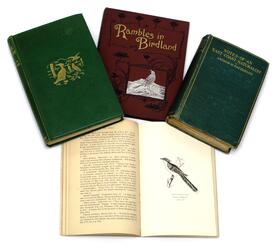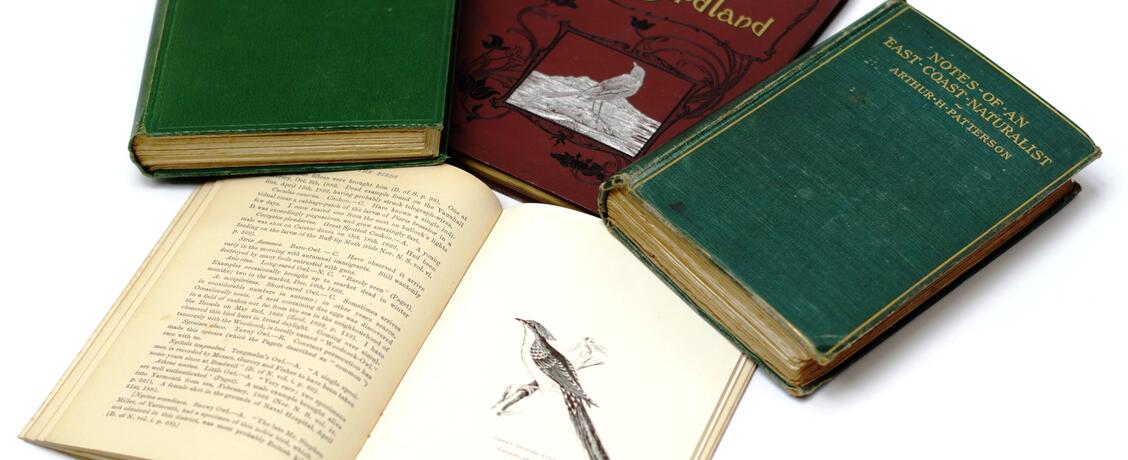An EDP Naturalist with a 100 Year Legacy
An EDP Naturalist with a 100 Year Legacy
By Elizabeth Talbot
Arthur Henry Patterson was born in one of the Great Yarmouth Rows in 1857. His father had been a shoemaker in Norwich before moving to Great Yarmouth and Arthur was the youngest of eight (some accounts say, nine) children, but the only one to survive beyond the age of 21.
He was educated at the Great Yarmouth PM Day School, where he was also a pupil teacher for a short time. At the age of 22 he became a postman and then a pedlar of ready-packed tea. He married during the following year, after which he settled down to the unusual mix of being an attendant at the YMCA and a taxidermist. He eventually progressed to become a School Board Attendance Officer (or, local truant officer) between 1892 and 1926, but not before he had tried his hand at being a sewing machine salesman, a zookeeper, and a showman!
However, it is what Arthur Patterson enthused about as private interests that forms his important legacy: he developed an interest in the nature which surrounded him at a very early age and his passion punctuated every spare moment of his adult life. As he grew older, he spent much of his spare time on Breydon Water where he befriended the old “Breydoners” … the wildfowlers, poachers and eel-catchers of the late 19th century. He kept detailed notes about the flora and fauna of the region in a series of diaries, which were later donated to the Norfolk Records office. Although he loved family life, he was not one for social occasions, and he listed his recreations as “solitary rambling, loafing around rivers and broads in a houseboat, hobnobbing with all sorts and conditions of men - eelers, smelters, fishermen and punt-gunners.”
Eric Fowler (1909-1981), otherwise known as Jonathan Mardle, a famous Norfolk dialect expert and respected EDP journalist, met Patterson and described him as: ”...a little, wiry, bearded man, wrinkled and weather-beaten, but very active and bright-eyed, like one of the dunlin he loved to watch on Breydon mud-flats.” In his final years, Patterson wrote: 'The question has often been put to me, "What can we do with Breydon?", to which he replied, "Let it alone." The entire area is now managed by the RSPB and is properly cared for and conserved: Patterson would surely have approved.
Throughout his working life Patterson was a dedicated Broadland naturalist and writer, his prolific literary output beginning in 1884 when he was 27. He was constantly submitting articles on nature to various publications, as well as writing – and illustrating – his own books. In an era when naturalists were generally gentlemen of leisure and of private means, with time and money on their hands, Patterson often struggled to gain the acknowledgement of his peers, but he never let his humble beginnings and limited finances stop his studies. Recognition of his work as a naturalist eventually came in May 1935 with his election as an Associate Member to the Linnean Society in London, the world’s oldest active biological society, just five months before his death.
In total, Patterson wrote 26 books and hundreds of articles, leaflets and periodicals. He observed the local people, recorded their way of life and dialect, and studied the nature and landscape which surrounded them. His observations were interesting and amusing then; now they are seen as precious records of times long gone and vital resources contributing towards 21st Century nature conservation. He wrote a series of letters in local dialect under the name of Melinda Twaddles Notions, which were published in the Eastern Daily Press, Great Yarmouth Mercury from 1893 until 1931; and for many years from the late 1890’s, he contributed nature articles to the Eastern Daily Press in Norwich, publishing under the modest pseudonym of John Knowlittle. He also regularly submitted humorous cartoons on local and political topics and the popularity of his work led to a demand for him to appear as a public speaker in the area, too.
His published works about Broadland included “Man and Nature on the Broads” (1895), “Rambles in Birdland” (1896), “Nature in East Norfolk” (1905), “Wildlife on a Norfolk Estuary” (1907), “Man and Nature of Tidal Waters” (1909), “Through Broadland in a Breydon Punt” (1920), “The Cruise of the Walrus” (1923), “Wild-fowlers and Poachers” (1929) and “Through Broadland by Sail and Motor” (1930). He also wrote a substantial history of PM in Yarmouth, From Hayloft to Temple (1903). Whenever copies of these books surface for sale they are highly sought after, and the rarer titles carry high prices. However, his works do appear in the dedicated Book auctions held at TW Gaze in Diss and the next specialist sale, to be held on 3 June is no exception.
On this occasion, eleven 1st editions of his works are to be offered, divided into five lots, with a total expectation of £870 – 1,280. Titles include “A Norfolk Naturalist” (1930), signed and inscribed by Patterson; “Native in Eastern Norfolk (1905), previously owned by renowned naturalist and wildlife photographer, Richard Kearton; “Notes of an East Coast Naturalist” (1904); “A Norfolk Naturalist” (1930); “Seaside Scribblings for Visitors (1887), with a signed dedication from Patterson to the prolific Broadland artist SJ Batchelder; and “Notes on Pet Monkeys and How to Manage Them” (1888), inscribed by Patterson to one of his children.
Catalogues will be available on twgaze.co.uk and all book enquiries regarding valuation and sale should be addressed to Robert Henshilwood R.Henshilwood@twgaze.co.uk

